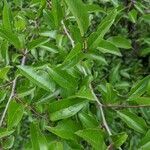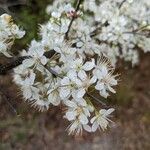Shrubs or trees, sometimes suckering, 10–60 dm, moderately thorny. Twigs with axillary end buds, usually glabrous, sometimes hairy. Leaves deciduous; petiole 3–14 mm, hairy, usually eglandular, sometimes hairy only adaxially, glandular distally, glands 1–3, ?discoid?; blade usually elliptic to broadly elliptic, sometimes oblanceolate to obovate, 3.5–8 × 1.5–4 cm, base usually cuneate to obtuse, rarely rounded, margins ?finely?, usually singly serrulate, sometimes doubly serrate, teeth sharp, usually eglandular, sometimes glandular, ?glands blackish, spheric?, apex usually acute, sometimes short-acuminate, abaxial surface hairy to glabrate, adaxial glabrous. Inflorescences 2–4(–6)-flowered, umbellate fascicles. Pedicels 5–22 mm, usually glabrous, sometimes hairy. Flowers blooming before or at leaf emergence; hypanthium tubular (often tubular-urceolate when dried), 2–4 mm, glabrous or hairy externally; sepals erect-spreading, ovate-oblong, 1.5–2.5 mm, margins usually entire, sometimes 2-fid at apices, ?ciliate?, abaxial surface hairy or glabrous, adaxial hairy; petals white, sometimes turning pink, obovate to suborbiculate, 3–8 mm; ovaries glabrous. Drupes red, yellow, dark blue, or nearly black, ?glaucous?, globose, 10–15 mm, glabrous; mesocarps fleshy; stones ovoid, slightly to ± flattened.
More
A small tree. The trunk is short. The crown is broad and flattened. It can form thickets. It grows 6 m high. The trunk is 15 cm across. The bark is dark brown and scaly. The leaves are 4-7 cm long by 2-4 cm wide. They are narrowly oval and have fine teeth along the edge. They are dark green above and paler underneath. The flowers are 15 mm wide and have 5 rounded white petals. There are 2-5 flowers in a cluster. They are on slender equal length stalks. The fruit is a plum. It is 10-15 mm wide and the skin can be black, red or yellow. The pulp is thick and sour. The stone is oval.
Dry, often sandy woods and river banks on the coastal plain. River swamps and hammocks. Sandy pine or oak woods, sandy barrens, shale ridges, limestone bluffs, rocky upland woods, old fields, roadsides; at elevations up to 800 metres.
More
Temperate. It grows along streams and in sandy or rocky slopes. It grows to 300 m altitude in the SE region of USA.



